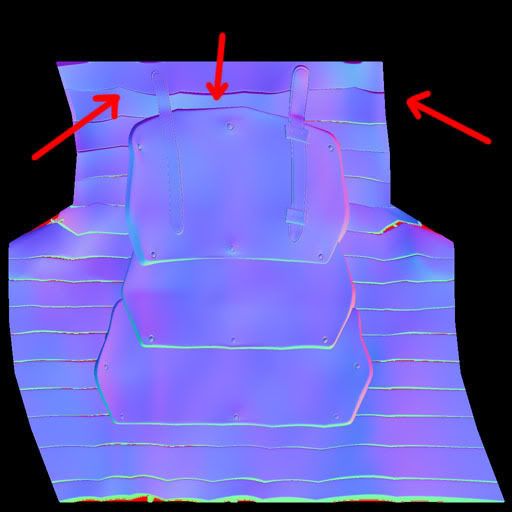The BRAWL² Tournament Challenge has been announced!
It starts May 12, and ends Oct 17. Let's see what you got!
https://polycount.com/discussion/237047/the-brawl²-tournament
It starts May 12, and ends Oct 17. Let's see what you got!
https://polycount.com/discussion/237047/the-brawl²-tournament
uneven normal map (swimming syndrome)
I'm having an hard time with normal maps projections that look uneven, my projection seems ok, but the normal map render are all looking like swimming. 
I also looked at this page: http://www.poopinmymouth.com/tutorial/normal_workflow_2.htm
im confused, i pull, tweak all my points but nothing changes the fact that my texture is uneven, i looked at my UVs, everything seem all square and clean.

I also looked at this page: http://www.poopinmymouth.com/tutorial/normal_workflow_2.htm
im confused, i pull, tweak all my points but nothing changes the fact that my texture is uneven, i looked at my UVs, everything seem all square and clean.
Replies
surely it doesn't matter how it looks on the UVs, as long as it looks fine when applied to the model in 3d view?
[/ QUOTE ] Yes absolutely
The projection cage look clean its all overlapping everything but i still get the uneveness
But basically should my lowpoly be over my highpoly when projecting or is it better to have your highpoly over your lowpoly ?
It not too good, in my opinion
http://www.poopinmymouth.com/tutorial/normal_workflow_3.htm
Have you thought about jsut adding those stripes in later? i.e. Render everything else first and then add the stripes in by hand? They will be as straight as you need, and it wont be that tough either.
[/ QUOTE ]
Aaah!! clever, i see what you mean now, took me a good 15 mins to decode this, i would do that but all my stuff is already modeled, i spent a good 2 months before hand just to get this mesh rolling and i wont back down, actually the texture distortion give my character an edgy look, kinda like roughed
However i might add some paint piece like you mentioned, very nice idea you had there, thanks for the scoop.
you will especially run into problems at the edges of cylinders @ caps, and other round objects.
the more verts your cage has, the smoother the normalmap will come out. It will work perfect on your low poly mesh.
..Oh never mind, I see how you do it. This would have been soooooo helpful to know before! Just add tessellate to your edit poly model and projection cage on top. Be sure to set tension at 0. Brilliant advice Moose!
I'm honestly not entirely sure how tesselating the low poly baking mesh will affect things, though. I guess I'll have to fire up Max and check it out.
(The normals in the middle of the tesselated flat plane are parallel to each other, so the interpolation will be happening closer to the original edge.)
Subdividing or tesselating with tension will change the normals but will bring the lowpoly closer to the highpoly. That way some errors like ray-misses or areas where the lowpoly is simply too different from the highpoly might render better.
However, the lowpoly-shading/triangulation/gouraud-shading one sometimes sees in normalmaps is NOT an artifact but neccessary to compensate for the gouraud-shading of the lowpoly. A normalmap without it might look cleaner as a bitmap, but actually it is kind of castrated.
Now an insteresting question would be: Since the normals between polygons are interpolated in the lowpoly anyways,(at least if they share a SG) and subdividing the actual mesh means "interpolating" the normals, too: How close will the normalmaps generated from those two meshes get to each other ? The gouraud-shading will be gone for sure but apart from that they should look pretty similar. In theory, that is.
I think in general, it wouldnt be optimal to use that 100% of the time, but instead when you're looking to clean up the normal map.
I wouldnt advise its use everywhere, but in the times i have needed to create normal maps, or make subtle fixes because the textures just arent working right, this has cured my problems.
Noren: yeah i get what you mean. most of the time though, the meshes i skin do not have as ellaborate SG's as in the past. The lighting, texures, and normal maps take care of for me that now. SG's seem to destroy the work the normal map does in cases (not ALL the time, but sometimes), and it generally comes out cleaner when the Normal map handles it. Not saying SG's aren't as important, but generally speaking i think the results are cleaner when they are avoided - if that is possible with the target engine.